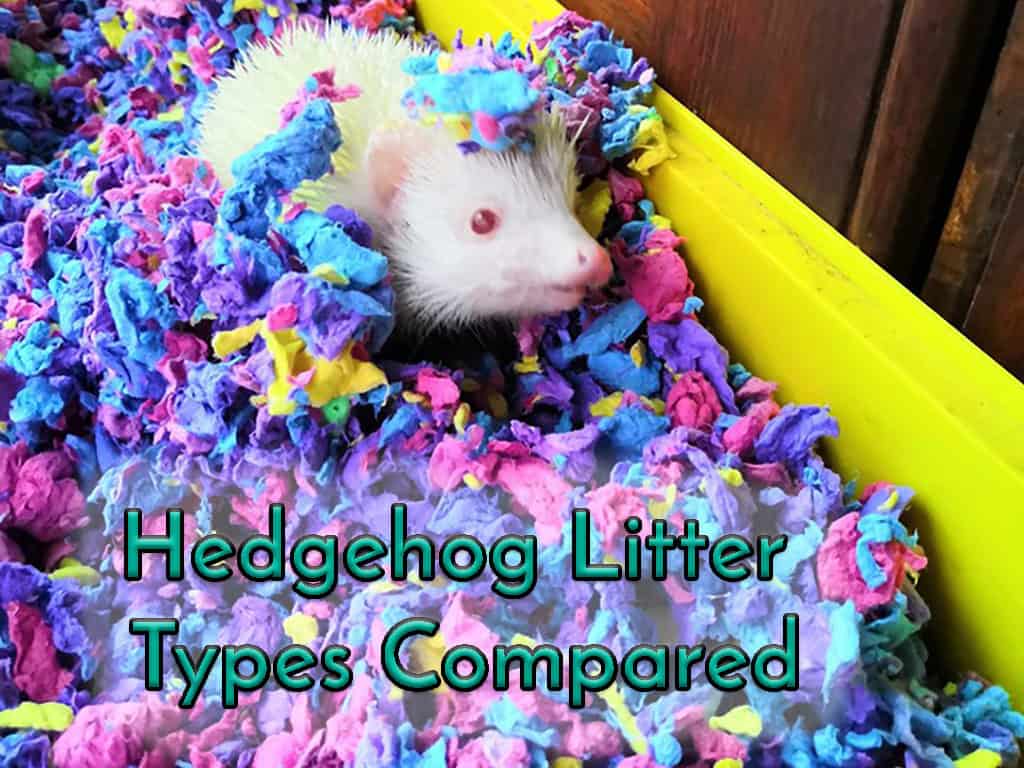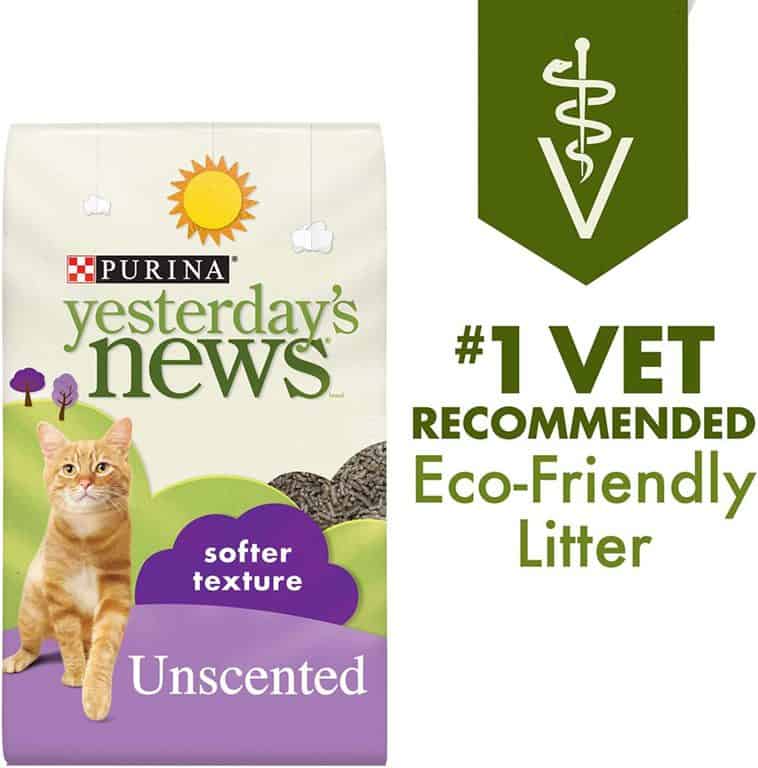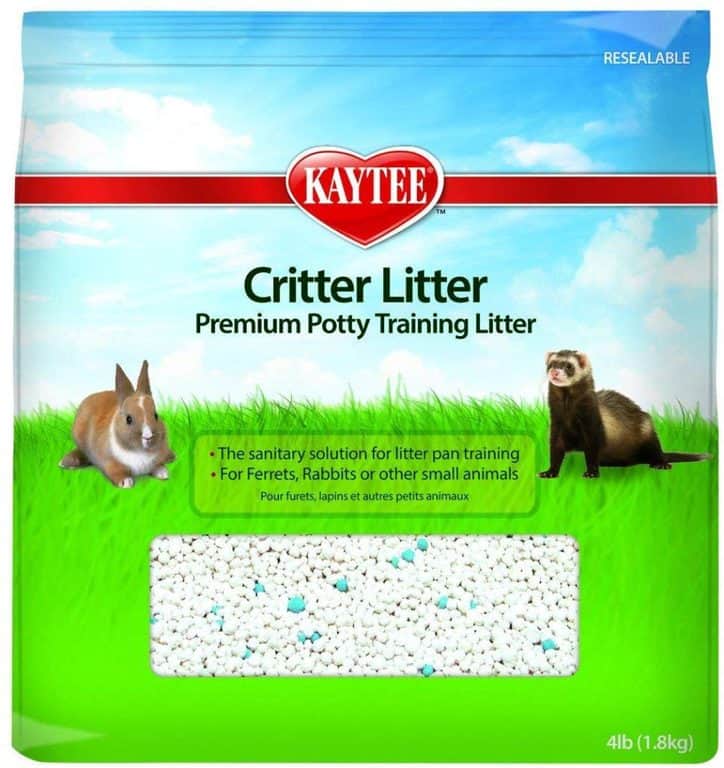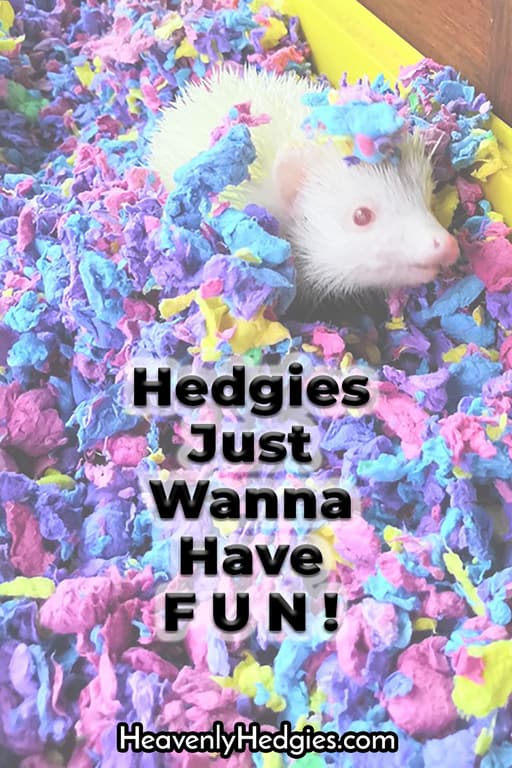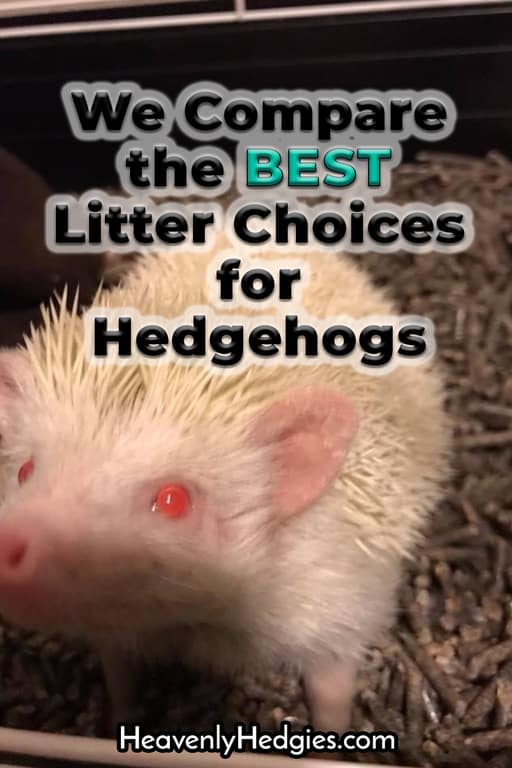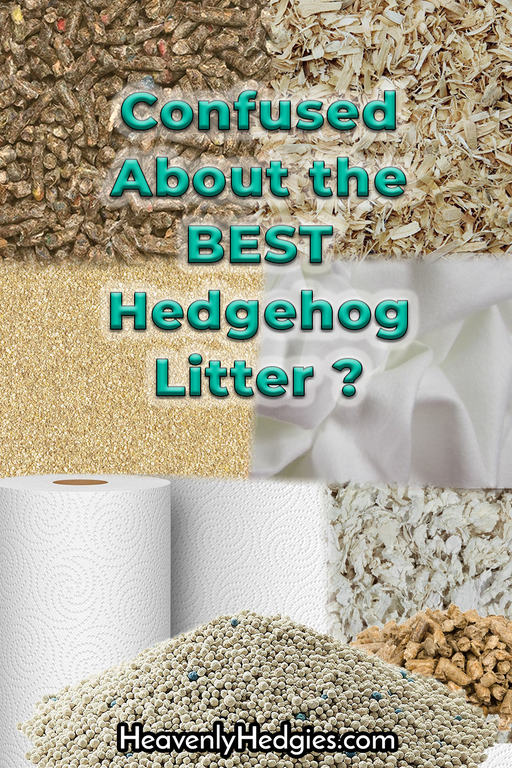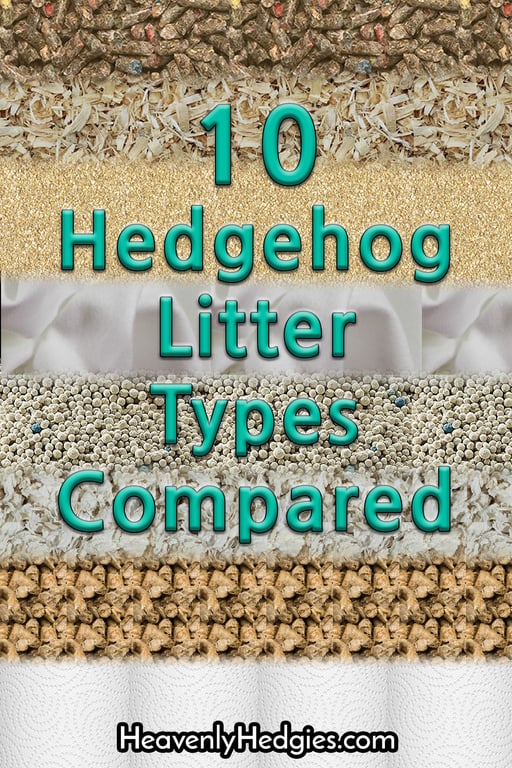With so many hedgehog litter types out there, it's difficult to pick the right one for your quill baby. We won't say that it's “fine to use whatever“, because there are definitely some options that are inappropriate for hedgies. And there are others that you could use and that would be fine, but they may not be the best choice for one reason or another. Just so that we're on the same page, the litter types we will be comparing is for the collection of your hedgie's waste and NOT what may be used for bedding. Some hedgehog owners will use the same litter for both purposes and others will use two or more types for litter and/or bedding. So, together we'll explore your options and uncover the advantages/disadvantages for different hedgehog litter types. Without wasting anymore time, let's dig in (ha ha).
A special thank you goes out to Pat Mamo for allowing us to use her picture of Sophie being cute in her colorful paper fluff hedgehog litter.
AFFILIATE DISCLOSURE: Heavenly Hedgies is an Amazon Associate. We have partnered with them and other reputable merchants when they sell something that we feel will benefit our readers. By purchasing through our links, we may earn a small commission on sales, that helps us continue to provide informative and educational information for hedgie lovers. And the best part is that there is no additional cost to you. Thank you for being a loyal and supportive reader here at Heavenly Hedgies.
The Most Common Litter Types Used By Hedgehog Owners
In this section, we will list the most common litter that is used by hedgehog owners. To gather that information, we posted polls in several communities. The results from 342 people who participated were pretty much what we expected. Below we will list the litter options in order from most frequently used to least frequently used. In addition, we will share the advantages, disadvantages, and other thoughts regarding each type. This way, you'll have some litter-specific information before deciding what to use with your hedgehog.
Fleece (42%)
When we posted our poll, it was unsurprising that fleece topped the list as the preferred choice for hedgehog litter usage. Since it is so widely available, on the surface of things, it seems to have many advantages. If you spread the initial investment cost of buying fleece over the lifespan of how long it lasts, it makes it the cheapest litter type you can use for your hedgie. Additionally, it comes in many prints and colors, so it creates a cute environment for your quill baby. You can wash it over and over again, so it seemingly appears to be environmentally friendly.
BUT, as you'll see later in this article, fleece isn't the holy grail of hedgehog litter. It's actually one of the LEAST eco-friendly options a hedgie owner can choose. Not only does it have a negative impact on the environment, it also places our hedgies at unnecessary risk for health issues. You can read more about it in the red box towards the end of this article. Another disadvantage is that it has no ability to control odor. If your hedgehog isn't litter trained to go in a litter pan that can be replaced periodically, urine will etch any porous surface beneath the fleece. Many people are under the misconception that plastic is not porous, but in actuality, many plastics have a coating that is not impervious to being etched by the ammonia in urine over time.
Paper Pellet (18%)
The second runner-up was paper pellet. This also wasn't surprising to us and is actually the type that Quilly uses as his primary litter. It has great absorbency and is pretty convenient to use. Environmentally, since it's mainly a product derived from recycled newspaper, we see that as eco-friendly. Most paper pellet brands are virtually dust free, which makes it a low risk for causing respiratory issues.
There's always disadvantages to everything and paper pellets for hedgehog litter are not an exception. Even though it is highly absorbent, it really has very little control over odor. We wind up changing Quilly's paper pellet litter daily because it gets pretty smelly after one night of our little poop factory. Another disadvantage we found was the color of the pellets. The color makes it very difficult to determine if there was ever blood in his urine (if we used pellet exclusively).
Some other cons of using this type of litter are the weight of the bags and the cost. If you have a hedgie that is prone to eating objects that are not food related, you might want to pass up this option. Since the pellets can swell substantially when wet, it can cause a bowel impaction if they swallow the pellets. Additionally, if you choose to freeze it for 24-48 hours before use to take care of any mites, it's fairly inconvenient scooping out containers to place in the freezer because the whole bag isn't going to fit. Not all hedgehog owners would take this measure, but we would rather not risk Quilly possibly getting mites. Wood and wood-based products are commonly infested by mites.
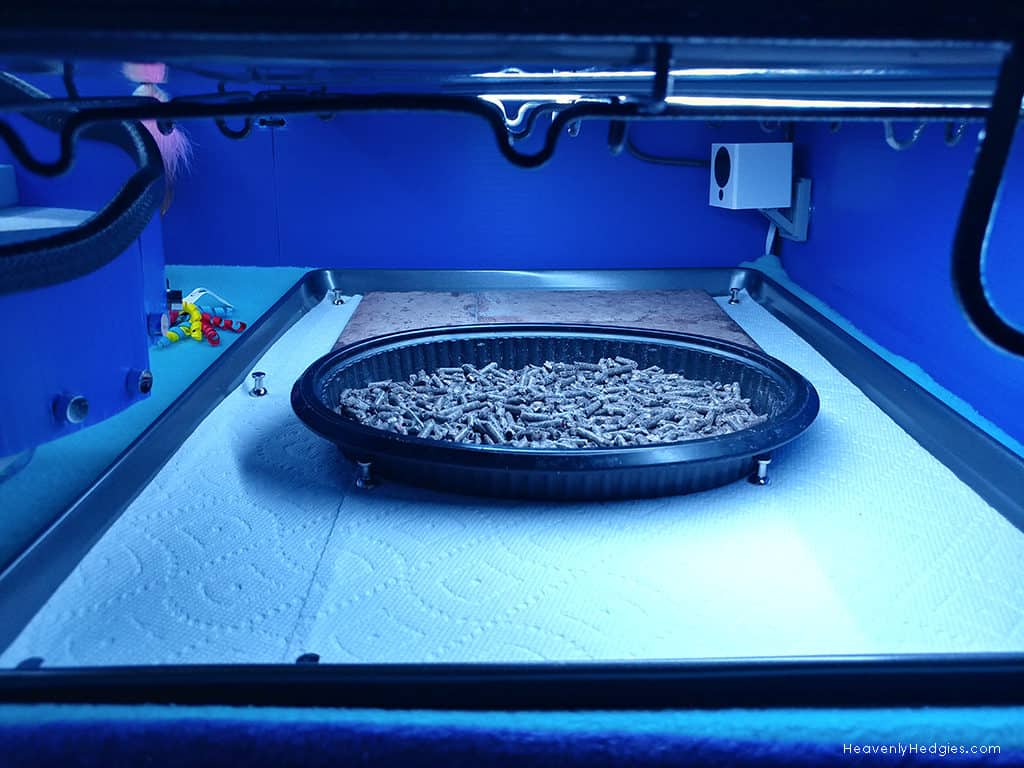
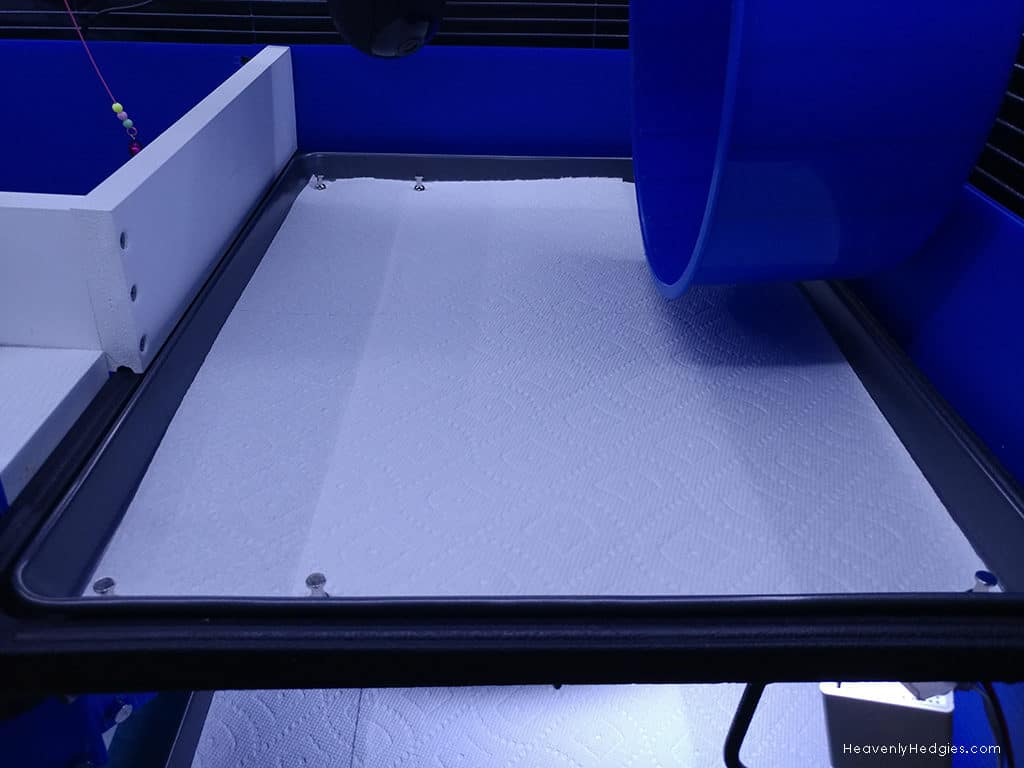
Paper Towel (11%)
The third runner-up actually surprised us. We didn't think that it was as widely used as it apparently is. In error, we assumed it would be towards the bottom of the list. This litter type is Quilly's secondary medium. We would prefer to use it as a primary source, but every time we try to transition away from paper pellets, he tears the paper towel to shreds. What's not to love about using paper towel? It is easy to lay down, can be purchased everywhere, is eco-friendly, and the cost isn't very high in comparison to everything other than fleece. As an added bonus, if you use white only, it's going to be very easy to see if your hedgehog has blood in their urine.
From our experience though, paper towel's odor control is terrible. Depending on the person taking care of the hedgehog, that could be a deal-breaker. We don't see it as one though, because just like a baby, you wouldn't want them sitting around in their waste. Like a diaper, it should be changed frequently. And we do change it frequently! As we mention before, some hedgies will scratch at it and tear it to shreds. We have learned though, that Quilly shreds more depending on the brand, so you might want to try a different brand if yours does this. As a word of caution, you should avoid paper towel prints that have red in them. The first time urine hits it and you see it, you may incorrectly think that your hedgie is bleeding. We stick to white only for Quilly…we don't need any hedgie anxiety moments.
Paper fluff (11%)
In fourth place is paper fluff for hedgehog litter. We can certainly understand why some would be attracted to this type. It's very soft and comes in many attractive colors. You can actually color coordinate your hedgehog's litter to their environment with this stuff. Since it's mainly manufactured from recycled paper products and will easily decompose, it's considered eco-friendly. This is the type of hedgehog litter that Quilly came in when we got him.
Like with the previously mentioned paper products, using paper fluff for their litter is not great for odor control. Also, from our experience, it's a nuisance because it gets caught on their quills, between their quills, and at times, stuck to their gender bits. We found that it was time consuming to clean up because it fluttered all over the place.
And while you can find this type of litter more easily than some of the options below, you probably won't be able to find it in a grocery store or pharmacy. We looked down the pet aisle in several grocery stores and pharmacies with general merchandise and it couldn't be found there. We were able to find it in a couple of “superstores” though. If you manage to come across paper fluff litter, try to get a neutral white kind so it's easy to see blood quickly.
Pee Pads (8%)
We considered using this option with Quilly, but decided that the benefit wasn't great enough for us to justify the expense. We tried pee pads on a get-away trip for the convenience, but it wasn't for us. Admittedly, they're very convenient to lay down and when they get soiled, you just gather it up and throw it away. Easy peasy.
Ultimately we thought about the cons of this litter type. Many hedgehog owners report that their quilly baby liked diving down under the pads instead of using them how they're intended. Other hedgie parents reported that their hedgehog scratched and clawed at it until the absorbent gel in the middle was revealed. That made a huge mess. We have not been able to find any authoritative evidence either way whether pee pads are unsafe for hedgehogs. That is something you'll have to decide.
Wood Shavings (4%)
It's not unusual to see hedgie parents using wood shavings as litter for their hedgehog. Pine and aspen are the two most common types of wood shavings used. It is easily found and cost effective. Pine has better odor control than aspen, but they're both about equally absorbent.
Worse than the paper fluff, we found wood shavings to be a pain in the arse to deal with. The shavings not only fluttered all over the place, but it got hung up on fleece blankets, and on our hedgehog. It was literally our least favorite type of hedgehog litter we've ever tried. Another drawback is that the price varies depending on the species of wood shavings. Also, a word of caution needs to be stated. Due to mites being commonly found in wood, this hedgehog litter NEEDS to be frozen for 24-48 hours. Another possibility is skin rashes. There have been numerous reports of contact allergies due to trace amounts of sap and resin that may be in several wood shaving varieties that haven't been kiln dried. So, if you prefer to use wood, finding a brand that has gone through a thorough process of heating like this one here, which eliminates harmful bacteria and is much cleaner.
Wood Pellet (4%)
Wood pellets used for hedgehog litter are much easier to use than wood shavings. They have good odor control and great absorbency too. Clean up is comparable to paper pellet, so you likely won't go wrong here.
The disadvantages of wood pellet is in the inconvenience of finding it and the weight of the bags. Additionally, since mites are commonly found in wood products, it definitely needs to be frozen for 24-48 hours. The manufacturing process to pelletize the wood should eliminate the risk of contact allergies, but if you do see signs, suspect the litter as the cause.
Corn Pellet (1%)
When it comes to environmental friendliness, it's hard to find fault with corn pellet litter! Due to the abundance of corn production, it's not very expensive either. On top of these attributes, clean-up is pretty easy.
In spite of all the positives, there are enough disadvantages that it wasn't a good fit for us to use for our hedgehog's litter. When we tried it, we found that it didn't have good odor control. In fact, the mixture of Quilly's waste with the corn pellet's was odd, but maybe it was due to the brand we bought. While that wouldn't have been a total deal-breaker, eating the litter was. We couldn't have Quilly nibbling the litter. Also, it wasn't convenient to purchase because the only place near us that had it was TSC. We were also concerned that the small size of the pellets might stick to his boy parts and up into the penile sheath.
Sand/Clay (bentonite) (1%)
Using sand or bentonite clay for a litter option may work for some people and we can understand the attraction. After all, it absorbs moisture almost on contact. And, it's certainly widely available, plus easily disposed of without being a detriment to the environment. Seems like great stuff to use, huh?
Sadly, the risks with it outweigh the benefits in our opinion. Both of these mediums suck moisture, and that includes skin moisture. Hedgehogs already have dry skin issues, so using a litter that sucks moisture doesn't make a lot of sense to us. Many hedgehogs are quirky and lay in their litter pan (including Quilly). So there is a high chance that it can get into the penile sheath, especially with sand. It can get into girl hedgie bits too, but it tends to be a larger issue with males. The bentonite clay poses a severe health risk if your hedgehog ingests it, so it's ill-advised if your hedgehog likes to eat everything.
The Hedgehog Litter Types You Should Avoid
We believe that owning a hedgehog should be a fun and stress-free experience. At Heavenly Hedgies, we don't like to give a list of hedgie commandments. You're the pet owner and you have to make the choices that fit with your lifestyle and beliefs. Our job is to present you with the facts, which include the good, the bad, and the ugly. What you do with that information is between you and your hedgie.
Along those lines, we strongly suggest that you avoid using certain types of hedgehog litter, but you're free to make your own choices and we won't judge you. Cedar wood shaving/pellets, sawdust and scented cat litter fall into that category. Hedgehogs are curious and like to lick and taste all types of things, but they have no idea that something may be toxic or not.
What's Wrong With Cedar Litter And Sawdust for Hedgies
Cedar used to be popular due to it's aromatic properties. Since no one likes the smell of waste, cedar's popularity resulted because it is pretty effective at masking the odor and it didn't have to be changed as frequently. The problem is that there are species of cedar that contain plicatic acid, and it's not possible to know what species are in the bag that is sitting on the shelf for use as litter. In a study involving 185 human subjects, “plicatic acid induced late asthmatic reactions alone in 44%, dual (immediate and late) reactions in 49%, and immediate reactions alone in 7%”. Now keep in mind that the sense of smell is keener and the respiratory system is frailer in hedgehogs than in humans. Cedar litter presents an avoidable risk for respiratory complications in hedgehogs.
And while we're on the topic of respiratory issues, it should be fairly obvious that the small particulate nature of sawdust makes it risky for hedgehogs. Not only can it jeopardize their breathing passageways, but because they are low to ground, sawdust can get where it really shouldn't go on both male and female hedgehogs. If sawdust – especially soiled sawdust – were to get caught in the vulva of the female or the penile sheath of the male, it can lead to a UTI (urinary tract infection).
The Problem With Using Scented Cat Litter for Hedgehogs
Most cat litter that has fragrance to help mask odor has synthetically created scent. Synthetic fragrance was discussed in a recent Ask Quilly video, “Are Scented and Air Fresheners Harmful To Hedgehogs?” To recap that episode, man-made fragrances are primarily made from carcinogenic waste products left over from the petroleum refinement process along with formaldehyde (another carcinogen). Given a hedgehog's propensity towards a variety of cancers (especially reproductive cancers), why introduce this type of litter when there are so many other healthier choices?
Hedgehog Litter Comparison Chart
Our comparison chart gives you a quick visual comparison reference for the most common types of hedgehog litter available. You won't find uncommon litter types like sphagnum moss or coconut fibers, which are types of litter that exist, believe it or not. Each type of hedgehog litter listed was scored on a variety of attributes, with 1 being the lowest and 5 being the highest. Each hedgehog litter type then has a total score for all the attributes combined. Please read the advantages and disadvantages of each hedgehog litter type above. A high score DOES NOT necessarily mean that it's a good option for your hedgie!
| Safety | |||||||
| Fleece | |||||||
| Paper fluff | |||||||
| Paper pellets | |||||||
| Paper towels | |||||||
| Newspaper | |||||||
| Wood shavings | |||||||
| Wood pellets | |||||||
| Pee pads | |||||||
| Corn pellets/bits | |||||||
| Sand/Bentonite Clay |
How the Hedgehog Litter Attributes Were Evaluated
With most things, the weight given to any particular attribute can be subjective. We strive to be as objective as possible in all information that we share on our website. Before anyone gets their dander up and applies their own opinion to our comparison, we decided we would share the factors that influenced each attribute:
- Safety – This measure strictly relates to the hedgehog and how safe the litter medium is for them to use. Factors such as exposure to potentially harmful chemicals was considered. We also looked at dangers posed by ingesting the litter and particulates getting stuck in the vulva or penile sheath of the hedgehog.
- Ease of Use – This was not only based on how easy the litter type was to change. We factored a panoramic view into this. We considered things like the need to freeze, common package weight, difficulties in clean-up, and the frequency it needed to be changed.
- Availability – Litter options that could be found at most any grocery store, general department store, online and pet stores got the highest scores. Hedgehog litter that was mostly found in general department stores, pet stores and online scored lower. Litter that could only be found in pet stores and online scored lower yet. And the lowest scores went to litter products that require a farming-type store (like TSC or Farm & Fleet) and online.
- Odor control – The bottom line on how we scored this was based on how quickly we were able to smell hedgehog waste odor in a closed room from the time it was freshly placed.
- Eco-Friendly – This category is also a panoramic view of several factors. When considering any litter medium's eco-friendliness, you have to look at the impact of the manufacturing process and the elimination process. What resources go into that? Since one of the staff here is a mechanical engineer, the scores were based on the complete litter product cycle – from manufacturing all the way through disposal. The findings were unexpected to us!
- Cost – While we would love to travel about and do price comparisons on hedgehog litter, that's not really very practical. Since locality can affect the price of products, we decided that the fairest thing to do would be to make all price comparisons using online pricing. Additionally, since fleece is washed instead of disposed, we factored in the cost of laundering to arrive at a more accurate cost.
The US has the highest tap water contamination rate—microfibers existed in 94 percent of the samples tested.
Given that hedgehogs have a propensity towards cancer and the number one recommendation for litter or bedding is fleece, you might want to weigh the convenience against the risk. Also if you factor the high cost of veterinary care for cancer in a hedgehog, you really aren't saving anything by using fleece. At Heavenly Hedgies, we will be taking measures to convert all of Quilly's synthetic fabrics to organic fabrics like cotton and bamboo.
Final Thoughts on Hedgehog Litter Types
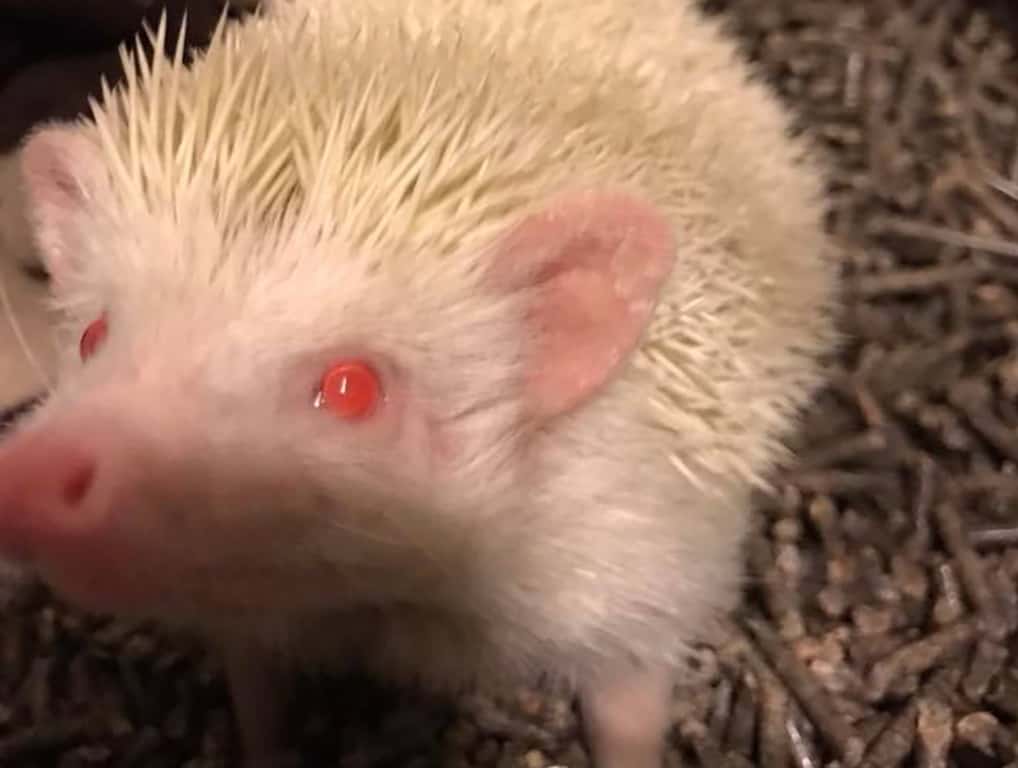
Those of you who pay close attention to the details will notice that we mentioned newspaper in our chart, but didn't give the advantages and disadvantage of it with the other hedgehog litter options. It wasn't on oversight. We didn't have a statistically significant number of people that use it from our poll data. If you're into thrifty living, you can make your own newspaper litter by following the steps found in this article on treehugger.com. We personally don't use it because we just don't have time for such steps. Due to the easy way that the ink comes off, we don't recommend that you use newspaper without washing it as advised in the article.
When we embarked on this journey to give our readers a comprehensive comparison of hedgehog litter, we never dreamed that there were so many factors to consider! In our attempt to provide you with the options, we learned a few things ourselves. As a result, we will be making some litter changes that we hope Quilly will be receptive to. Our sincere desire is for you to have the knowledge you need to make an informed decision about what hedgehog litter types are best for your lifestyle and your lap cactus.
